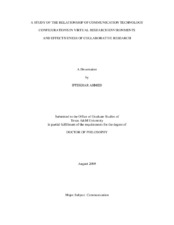| dc.description.abstract | Virtual Research Environments (VRE) are electronic meeting places for
interaction among scientists created by combining software tools and computer
networking. Virtual teams are enjoying increased importance in the conduct of scientific
research because of the rising cost of traditional scientific scholarly communication, the
growing importance of shared academic research by geographically dispersed scientific
teams, and changes in the corporate research structures. New facilities provided by the
Internet technology enhanced this situation. Currently, our knowledge about VRE-based
scientific communication and what makes it effective is relatively immature in terms of
understanding technology (interface, architecture, and software evaluation), system
management (software systems, visualization, scalability), knowledge bases, expert
systems, and coordination. Moreover, we do not have a comprehensive classification
scheme for virtual research environments primarily from a technological viewpoint. This study provided an analysis of VRE from a technological standpoint and
developed a conceptual model that identified factors facilitating collaboration
effectiveness with a primary focus on technology. VRE portals were at the core of the
investigation as they are the entry points for VRE related information and resource
access. First, the study developed a methodological framework for characterizing VREs,
applied that framework to examine and classify existing VRE systems, and developed a
new classification. Then, the study established a relationship between the technological
profiles of various types of VREs and their productivity. Study results show that the
technological arrangements of the VRE neither depend upon scientific discipline nor the
existing functional typology. The study did not identify a significant presence of
communication and collaboration technologies within the VRE systems. However,
results indicated that there were a correlation between communication and collaboration
technologies and VRE effectiveness. | en |


